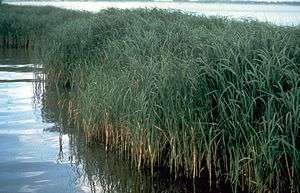Halophyte
A halophyte is a salt-tolerant plant that grows in soil or waters of high salinity, coming into contact with saline water through its roots or by salt spray, such as in saline semi-deserts, mangrove swamps, marshes and sloughs and seashores. The word derives from Ancient Greek ἅλας (halas) 'salt' and φυτόν (phyton) 'plant'. An example of a halophyte is the salt marsh grass Spartina alterniflora (smooth cordgrass). Relatively few plant species are halophytes—perhaps only 2% of all plant species.

The large majority of plant species are glycophytes, which are not salt-tolerant and are damaged fairly easily by high salinity.[1]
Classification
Halophytes can be classified in many ways. According to Stocker (1933), it is mainly of 3 kinds, viz.
1. Aqua-halines
- Emerged Halophytes (most of the stem remains above the water level)
- Hydro-halophytes (whole or almost whole plant remains under water)
2. Terrestro-halines
- Hygro-halophytes (grow on swamp lands)
- Mesohalophytes (grow on non-swamp, non-dry lands)
- Xero-halophytes (grow on dry or mostly dry lands)
3. Aero-halines
Again, according to Iversen (1936), these plants are classified with respect to the salinity of the soil on which they grow.
1. Oligo-halophytes (amount of NaCl in the soil is 0.01 to 0.1%)
2. Meso-halophytes (amount of NaCl in the soil is 0.1 to 1%)
3. Euhalophytes (amount of NaCl in the soil is >1%)[2]
Habitats of halophytes
Major habitats where halophytes flourish include mangrove swamps, sand and cliff shorelines in the tropics, salt deserts and semi-deserts, the Sargasso Sea, mudflats and salt marshes, kelp forests and beds, salt lakes and salt steppes of the Pannonian region, wash fringes, isolated inland saline grasslands, and in places where people have brought about salination. [3]
Salt tolerance
One quantitative measure of salt tolerance (halotolerance) is the total dissolved solids in irrigation water that a plant can tolerate. Seawater typically contains 40 grams per litre (g/l) of dissolved salts (mostly sodium chloride). Beans and rice can tolerate about 1–3 g/l, and are considered glycophytes (as are most crop plants). At the other extreme, Salicornia bigelovii (dwarf glasswort) grows well at 70 g/l of dissolved solids, and is a promising halophyte for use as a crop. [4] Plants such as barley (Hordeum vulgare) and the date palm (Phoenix dactylifera) can tolerate about 5 g/l, and can be considered as marginal halophytes.[1]
Adaptation to saline environments by halophytes may take the form of salt tolerance or salt avoidance. Plants that avoid the effects of high salt even though they live in a saline environment may be referred to as facultative halophytes rather than 'true', or obligatory, halophytes.
For example, a short-lived plant species that completes its reproductive life cycle during periods (such as a rainy season) when the salt concentration is low would be avoiding salt rather than tolerating it. Or a plant species may maintain a 'normal' internal salt concentration by excreting excess salts through its leaves, by way of a hydathode, or by concentrating salts in leaves that later die and drop off.
In an effort to improve agricultural production in regions where crops are exposed to salinity, research is focused on improving understanding of the various mechanisms whereby plants respond to salinity stress, so that more robust crop halophytes may be developed. Adaptive responses to salinity stress have been identified at molecular, cellular, metabolic, and physiological levels.[5]
Examples
Some halophytes are:
- Anemopsis californica (yerba mansa, lizard tail)
- Atriplex (saltbush, orache, orach)
- Attalea speciosa (babassu)
- Panicum virgatum (switchgrass)
- Salicornia bigelovii (dwarf glasswort, pickleweed)
- Spartina alterniflora (smooth cordgrass)
- Tetragonia tetragonoides (warrigal greens, kōkihi, sea spinach)
- Dunaliella (a green alga)
As biofuel
Some halophytes are being studied for use as "3rd-generation" biofuel precursors. Halophytes such as Salicornia bigelovii can be grown in harsh environments[6] and typically do not compete with food crops for resources, making them promising sources of biodiesel[7] or bioalcohol.
References
- Glenn, E. P.; et al. (1999). "Salt tolerance and crop potential of halophytes". Critical Review in Plant Sciences. 18 (2): 227–55. doi:10.1080/07352689991309207.
- "Halophytes: Classification and Characters of Halophytes".
- Kapler, Adam. 2019. Habitats of Halophytes. In: Halophytes & Climate Change: Adaptive Mechanisms and Potential Uses. Edited by Mirza Hassanuzzaman, Sergey Shabala, & Masayuki Fujita. CAB International. Pp. 19-37.
- Glenn, E. P.; Brown, J. J.; O'Leary, J. W. (1998). "Irrigating Crops with Seawater", Scientific American, Vol. 279, no. 8, Aug. 1998, pp. 56-61.
- Gupta, Bhaskar; Huang, Bingru (3 April 2014). "Mechanism of Salinity Tolerance in Plants: Physiological, Biochemical, and Molecular Characterization". International Journal of Genomics. 2014: 701596. doi:10.1155/2014/701596. PMC 3996477. PMID 24804192.
- "Fact Sheet: Alternative Fuels". IATA. December 2013. Archived from the original on 2014-02-01. Retrieved 2014-01-28.
- Glenn, Edward P.; Brown, J. Jed; O'Leary, James W. (August 1998). "Irrigating Crops with Seawater" (PDF). Scientific American. USA: Scientific American, Inc. 279 (August 1998): 76–81 [79]. Bibcode:1998SciAm.279b..76G. doi:10.1038/scientificamerican0898-76. Retrieved 2008-11-17.